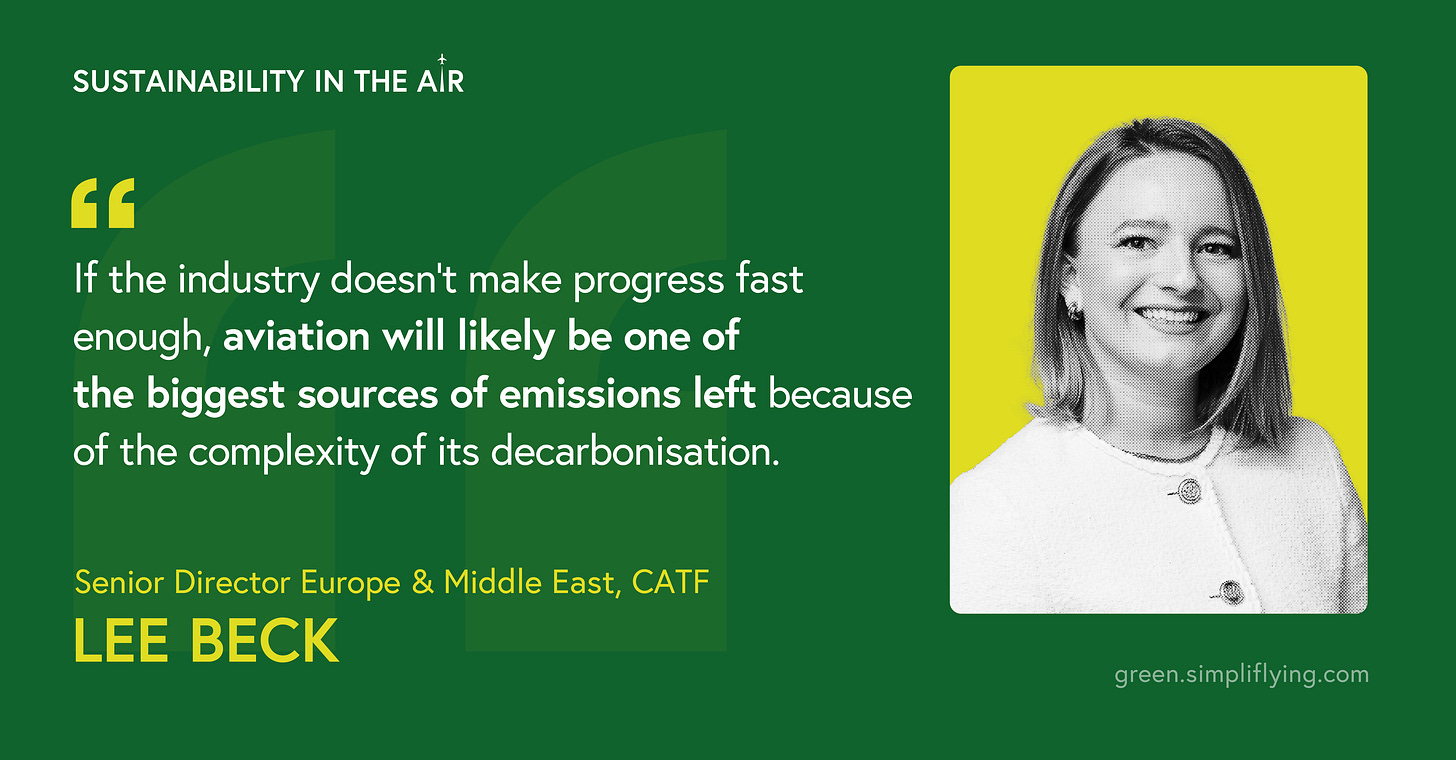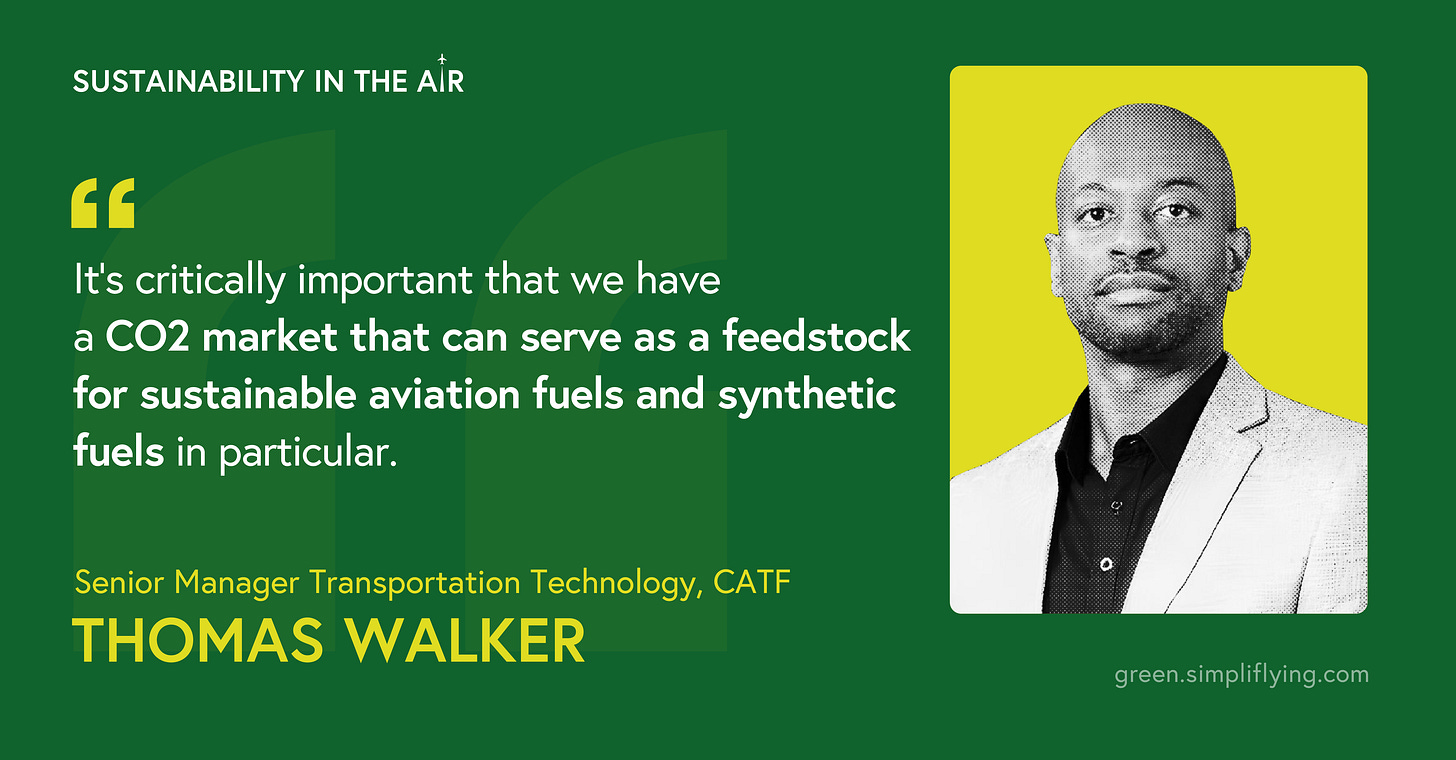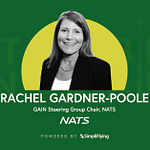In this episode of our 'Sustainability in the Air' podcast, Lee Beck and Thomas Walker of the Clean Air Task Force (CATF) speak with SimpliFlying's CEO Shashank Nigam about the complex challenges and innovative solutions for decarbonising the aviation industry. The conversation delves into various technological options, policy measures, and collaborative efforts needed to achieve a sustainable future for air travel.
CATF is a global non-profit climate organisation focused on overlooked solutions for decarbonisation across the energy system. Their work encompasses clean electricity, industrial decarbonisation, and transportation decarbonisation, with a particular emphasis on next-generation solutions.
Here are the key highlights of the conversation with Lee Beck and Thomas Walker:
CATF's role in aviation decarbonisation (2:27)
The potential of synthetic fuels in aviation (5:14)
The potential of hydrogen-powered aircraft (14:33)
Ammonia as a future aviation fuel (19:51)
Electric aircraft and their current limitations (23:06)
GREET model and lifecycle analysis concerns (25:30)
Carbon capture and storage importance (28:48)
The future of sustainable aviation (51:23)
Keep reading for a quick overview of the episode.
Why a “50% synthetic” future is critical for decarbonising aviation
At the heart of CATF's strategy is a strong emphasis on synthetic fuels. Unlike traditional biofuels, which face scalability and sustainability challenges, synthetic fuels offer a potentially abundant, carbon-neutral alternative.
The conversation enumerates several concerns about over-reliance on biofuels for aviation, including competition with food production, negative impacts on natural ecosystems, and limited scalability. Walker argues:
"We see that to keep up with the aviation market, biofuel production might need to increase by a factor of six by mid-century. And we think that's unrealistic. Maybe it increases by a factor of two or three, which is still a lot, but that will still leave about half of the aviation demand uncovered."
He also discusses CATF's recent report on aviation decarbonisation, which suggests that synthetic fuels could make up over 50% of aviation fuel by 2050 in an optimistic scenario.
These fuels, created by combining CO2 captured from the air with hydrogen, are considered "drop-in" fuels, meaning they can be used in existing aircraft without significant infrastructure modifications. Moreover, the production process of synthetic fuels is carbon-neutral when using renewable energy sources, making them an attractive option for long-haul flights where other low-carbon alternatives may not be feasible.
However, the high production costs of synthetic fuels present a significant challenge. To address these challenges, CATF advocates for a multi-pronged policy approach. This includes incentives for clean hydrogen production, support for carbon capture technologies, and the implementation of clean fuel standards.
Five ways CATF is thinking the future of sustainable aviation
1. The question of hydrogen vs electric aviation
CATF's approach is characterised by a willingness to explore multiple technological pathways. This includes not only synthetic fuels but also hydrogen-powered aircraft and even more exotic options like ammonia as a fuel source.
Beck underscores the importance of this diversity in thinking:
"From our perspective, we need as many decarbonisation options as possible so each country or region can decarbonise and transform its energy system with the solutions that are most suited for its individual geographic resources and economic circumstances."
Hydrogen aircraft, in particular, offer the tantalising prospect of truly zero-emission flights. As Walker explains, "Hydrogen aircraft are really, really interesting because the idea of powering an aircraft with a fuel that doesn't have any carbon at all is very appealing. It's not about net zero, it's zero from the start."
However, there are significant infrastructure challenges associated with hydrogen: "You would need gate redesigns. You would need to have all the fuel lines remanaged and checked for leaks, which is another major hydrogen issue. Hydrogen, being the smallest element in the universe, easily leaks. And if you have leaking hydrogen, it's also extremely flammable,” explains Walker.
Moreover, Walker views electric aviation as having limited potential in the near to medium term, primarily confined to small aircraft with 5-10 seats and short-distance flights of 200-300 miles. He sees possible applications for very short hops between nearby cities, like Boston to New York, but anticipates significant challenges for longer routes due to battery limitations. He suggests that electric aviation is unlikely to play a major role in decarbonising the industry, especially for medium to long-haul flights.
2. Policy measures for synthetic fuel adoption
To achieve widespread adoption of synthetic fuels, Beck and Walker suggest several policy measures:
Hydrogen production incentives: Supporting the development of clean hydrogen production through subsidies and targeted programmes.
CO2 capture support: Investing in direct air capture (DAC) technology and carbon capture and storage (CCS) projects.
Clean fuel standards: Implementing standards that create a market for cleaner fuels by assigning credits to low-carbon fuel producers.
Research and development funding: Providing continued support for R&D to improve efficiency and reduce costs of synthetic fuel production.
Walker further explains how a clean fuel standard could work:
"It's basically a standard where if you produce fuel that is below a target, and you're below that, we'll give you a credit. If you're above that, you have to then buy credits, and it creates a market where you can trade credits for the cleaner fuels. The dirtier fuels need to buy those credits to incentivise people to make cleaner fuels."
3. The case for Ammonia
Intriguingly, CATF also sees potential in ammonia as an aviation fuel. Walker explains:
“Since it's NH3, it actually has more hydrogen per litre than liquid hydrogen itself. The density of liquid hydrogen is low. Ammonia is much higher. You can pack more of it on the airplane; it solves your energy density problem."
Moreover, ammonia is easier to handle and store than hydrogen, potentially offering a middle ground between conventional fuels and more radical alternatives. However, toxicity concerns and the need for specialised engines present significant hurdles to adoption. Walker suggests that ammonia might first be introduced in cargo operations to prove the technology before passenger use.
(It’s worth noting that in January 2024, a report by the Tyndall Centre for Climate Change Research assessed the potential of ammonia as a low-carbon aviation fuel. While acknowledging its advantages, the study found that its technological readiness is low and more regulations are needed to ensure its sustainability. The report concluded that it's too early to consider ammonia a certain option for aviation decarbonisation, highlighting the need for greater incentivisation of alternative fuel development.)
4. The importance of carbon management
Throughout the discussion, the important role of carbon capture and storage (CCS) technologies becomes apparent. As Beck states:
"Carbon management technologies are actually close to my heart and really form an important piece of Clean Air Task Force's work, particularly in industrial decarbonisation.”
This dual role of CCS – both as a means of reducing industrial emissions and as a key component in synthetic fuel production – explains its importance in CATF's vision for sustainable aviation.
Beck stresses the need for flexible CO2 transport options. "We advocated in the TEN-T regulation, to include multiple modes of CO2 transportation because we wanted to make sure that CO2 capture and CO2 storage or utilisation projects have access to as many options as possible," says Beck.
(Note: The EU's Trans-European Transport Network (TEN-T) policy is a comprehensive strategy for developing an efficient, sustainable, and integrated transport infrastructure across the European Union. Key aspects include improving rail travel speeds, implementing a unified signalling system, connecting major airports to long-distance rail, expanding freight terminals, promoting sustainable urban mobility, and deploying alternative fuel infrastructure.)
5. An options-based approach and international collaborations
Beck says that CATF emphasises the importance of maintaining multiple technological options for decarbonising aviation. Ultimately, the idea behind optionality is to have a portfolio of solutions. This approach recognises the complexity of the challenge and the likelihood that different solutions may be more appropriate in different contexts. It also provides a hedge against the risk of any single technology failing to deliver on its promise.
In addition, given the global nature of the aviation industry, CATF stresses the importance of international cooperation. Beck argues:
"Collaboration is hugely important because innovation globally, in theory, has to happen only once. You take the technology to market, like, say, what Germany and Denmark have done for solar and wind, and of course the UK, and then the technology can kind of spread globally.”
Despite the numerous challenges, both Beck and Walker express cautious optimism about the future of sustainable aviation. However, Walker does note an encouraging trend: "I've seen an increase in that collaboration over the past few years and overall recognition that aviation is a really major challenge."
‘Sustainability in the Air’ is the world’s leading podcast dedicated to sustainable aviation. Through in-depth conversations with top aviation leaders, we break through the clutter and provide a clear roadmap for a net-zero future.
For October 2024, we’re pleased to feature SITA as our exclusive Sponsor of the Month. SITA is a global IT provider for the air transport industry, helping airlines navigate complex environmental regulations. Discover how their Eco Mission tool can simplify compliance, reduce costs, and provide real-time insights to support your sustainability goals.














